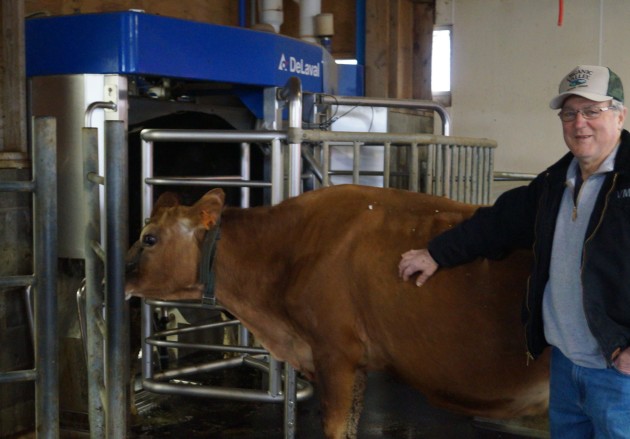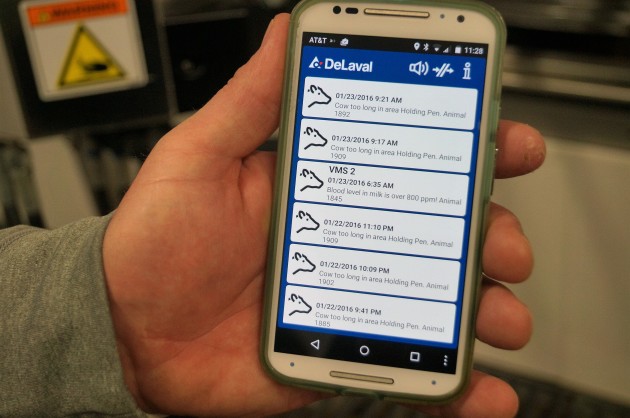BOT or NOT? This special series explores the evolving relationship between humans and machines, examining the ways that robots, artificial intelligence and automation are impacting our work and lives.
Image: Ron Austin with cow
Dairy farmer Ron Austin peers past the robot-controlled milking cups attached to a cow’s teats. The cows mostly decide when and how often they’re milked. (GeekWire photo by Alan Boyle)
OAKVILLE, Wash. – The Austin family’s cows seem a lot more contented since the robots took over the milking. It’s the humans, not the cows, who have had to make the biggest adjustments.
“At first, you’re a deer in the headlights,” Ron Austin recalled at the family farm, 90 miles southwest of Seattle. “You get a call from the robot, and you don’t know what to do. The cows learned faster than we did.”
The Austins and about a dozen other families in Washington state are part of a rising robot revolution in the dairy industry.
More than 30,000 autonomous milking machines have been sold around the world, and the trend is just now picking up speed in the United States. By 2025, as much as a quarter of the cows in North America could be milked by robots.
A milking robot doesn’t look anything like C-3PO or R2-D2. It’s basically a metal cabinet that’s positioned next to the cow’s stall.

A robotic arm extends out from the cabinet to sanitize the cow’s teats and hook up suction cups. Laser-scanning sensors make sure the cups go in the right places. The cups squeeze the teats so that milk flows through hoses and into a holding tank for analysis. When the computer senses that the flow has slowed to a trickle, the cow is unhooked, cleaned up and set loose to make room for the next one.
The cows don’t have to be chased into the milking pen. They want to come back, to get more of the tasty feed they’re served automatically while they’re in the stall. Each cow wears a RFID tag, so the computer knows how long since she’s been milked and determines when she should be let back in for another go-round. Computer-controlled gates are used to herd the cows in the proper order.
If something in the system isn’t right – for example, if a cow has been waiting in the pen for too long, or if blood is detected in the milk – the farmers get a robo-call on their smartphones. They can even tap on an app to fine-tune the system, without ever setting foot in the barn.
Milking app
A smartphone app sends an alert whenever the milking robots encounter something out of the ordinary. (GeekWire photo by Alan Boyle)
Why are robot milkers taking over from humans? It’s not just because of money.
“It may or may not increase profitability,” said Larry Tranel, a dairy field specialist for Iowa State University Extension and Outreach. “It may or may not increase cash flow.”
On the plus side of the balance book, the robots tend to cut down on the need for human labor. There’s also increased productivity: Instead of being milked only twice a day, the cows can unburden themselves up to six times a day. For the Austins, that translates to an 11 to 17 percent increase in daily milk output.
Robot-milked cows seem more at ease because they’re not spooked so much by all those jumpy humans. “Taking the people out of the picture gives the cows a relaxed environment,” said Scott Nehls, a technician for DeLaval, the company that made the Austins’ robots.
On the minus side, the machines are expensive: Jim Austin, Ron’s father and the family patriarch, figures that he spent half a million dollars to buy two robots and remodel the milking parlor. There’s repair and maintenance to consider, of course. And because the Austins are early adopters, they’ve had to spend more time and money on the transition than they anticipated.
“It’s been a rough couple of years,” Ron said.
Jim Austin and cow
Jim Austin stands alongside a cow waiting her turn to be milked. (GeekWire photo by Alan Boyle)
Despite the fact that the labor savings haven’t fully kicked in yet, the Austins say the prospects look good for recouping their investment – in part because the price they’re getting from the Organic Valley co-op has trended upward.
The big attraction has to do with quality of life: To milk 110 cows the old way, the Austins and their three hired workers had to hook up and take down milking machines for three to four hours at a stretch, twice a day, seven days a week. Sometimes the milking didn’t stop until 9 p.m.
“I tell you, that was getting old,” Jim said.
Now that the robots are on the scene, humans don’t have to set foot in the milking parlor unless something needs to be checked. Last year, Jim and his wife Janie celebrated their 50th wedding anniversary with the family in Hawaii while their workers kept an eye on things back home. There’s no more need for the daily milking marathon. “I don’t work as hard as I used to,” Jim admitted.
Based on the surveys he’s taken, Tranel said having that kind of flexible lifestyle is worth as much as $50,000 a year to dairy fa
